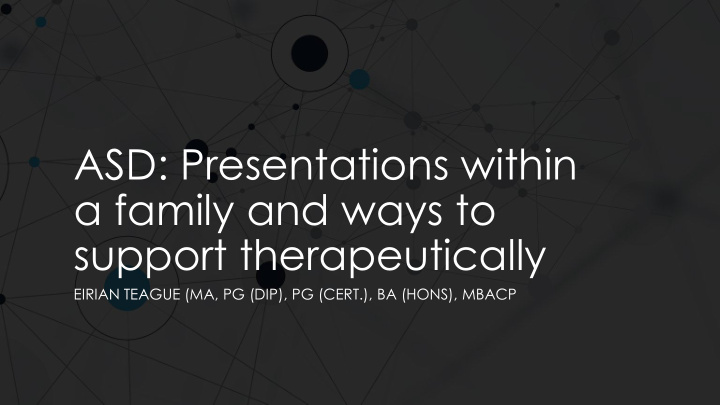



ASD: Presentations within a family and ways to support therapeutically EIRIAN TEAGUE (MA, PG (DIP), PG (CERT.), BA (HONS), MBACP
❖ Introductory assertions ❖ Why the development of resilience is significant for children and young people with ASD Overview of ❖ What is ASD ? (the SIGNS) presentation ❖ Using knowledge of the condition for adaptive practice ❖ Conclusions ❖ References
Introductory assertions There is currently not enough research to either count or The importance of language and discount the efficacy of a specific terminology used when working therapy . . . When adaptive with people with ASD practice has been made Autism Spectrum Disorder / ASC / Autistic person / person with Asperger's / Autism / Aspie/ autism Autistic / NT
Why the development of resilience is significant for Resilience → ‘the capacity to recover quickly from children and difficulties; toughness’ young people with ASD?
Statistics related to autistic children and young people Government statistics show that children with a statement (ambitiousaboutautism.org.uk There are around 100,00 of special educational needs and National Autistic Society – children diagnosed with ASD are six times more likely to be February 2020) (arguably more undiagnosed) excluded from school than children with no special educational needs Primary school pupils with 17% of autistic children have special educational needs are been suspended from school; twice as likely as other children 48% of these had been to suffer from persistent suspended three or more times bullying.
What is ASD? It is a lifelong It is a It is a condition It is a relatively new diagnosis (1940’s). However, there are condition(NT / ASD neurodevelopmental characterised by the biographical accounts that within families) condition ‘dyad of appear to list what we now know as ASD traits from the 16 th impairments’ (DSM -5) century (Tantam, 2012)
S = Social Interaction and verbal communication are impaired I = Imagination, ideas and creativity are reduced THE SIGNS G = Gestures and non-verbal communication OF ASD are limited (ASDinfoWales.co.uk) N = Narrow range of interests, routines and repetitive behaviours S = Sensory responses are unusual
Using knowledge of the condition for adaptive practice – some examples and suggestions (Caveat: Not all adaptions will be suitable for all people)
Try and find out if the child or young person is sensory avoidant or sensory seeking (if this information is available) Taking into account Can use this information when adapting the therapy room (dimming the lights / closing the blinds / turning a radio off / taking a ticking sensory clock out of the room) preference Using sensory toys as grounding objects (chewellry, fidget cubes, weighted blankets etc(!) ) Mindfulness
Find out what the child’s/young persons interests are Incorporate them into therapeutic work (! Only if the child chooses to – depersonalisation Use of special preference) interests in session Add figures to therapeutic worksheets Communicate via characters
Avoid the use of non-verbal communication to emphasise meaning or understanding (it may not be shared). Increased use of clarifying questions Use direct communication during sessions (Is that how you see it?) (What do you think I mean when I say that?)
Challenges Use of imagination Look out for with scaling / and generalised challenges in meaning scaling Alexithymia Make sessions as (Attwood & predictable as required Garnett, 2016)
Conclusions Increased knowledge will support practitioners confidence in spotting the SIGNS and supporting children and young people with recognised neuro-difference Autism-aware practitioners can support clients to develop their coping strategies to deal with an ever-changing world. This will hopefully add to the maintenance and development of internal resilience
Recommend
More recommend